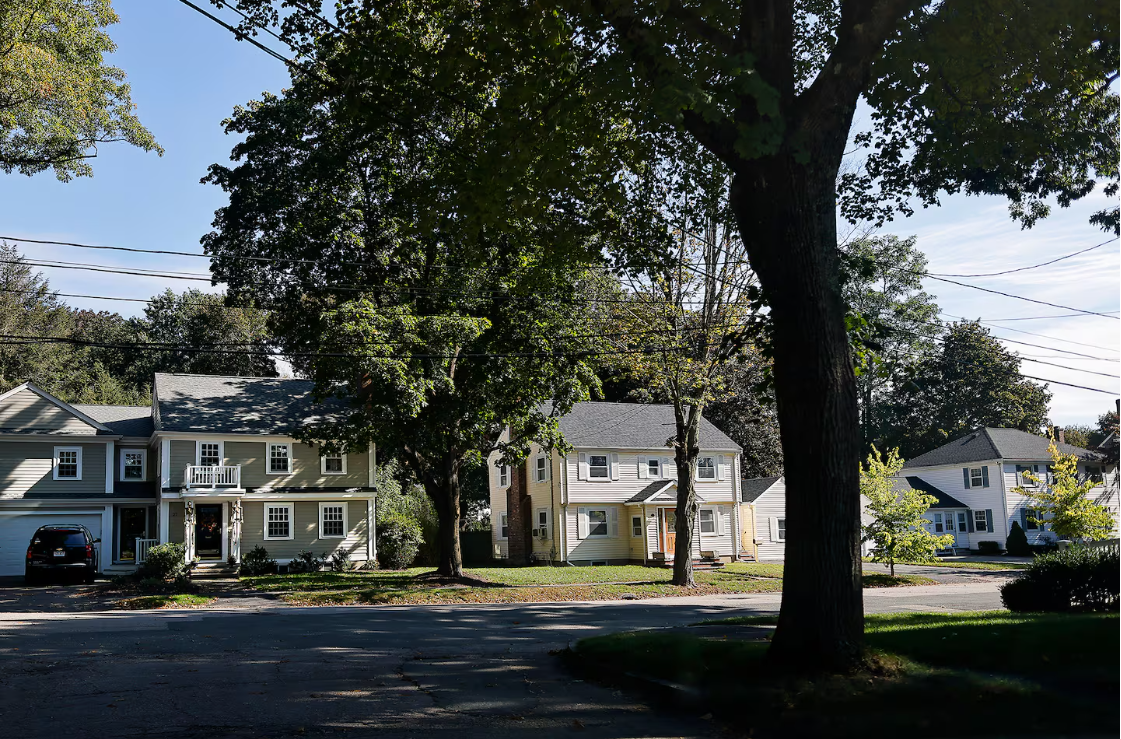大波士顿地区炙手可热的房地产市场是否开始回落?

【中美创新时报2024 年 8 月 21 日编译讯】(记者温友平编译)大波士顿地区独户住宅的中位售价在 7 月份为 925,000 美元,低于 6 月份约 960,000 美元的历史高点。在经历了一系列令人瞠目结舌的创纪录高点之后,大波士顿地区房价的狂热可能终于要消退了。《波士顿环球报》记者Dana Gerber 对此作了详细报道。
根据大波士顿房地产经纪人协会周三公布的数据,该地区 7 月份单户住宅的平均售价为 92.5 万美元,低于 6 月份约 96 万美元的历史最高价,仅比去年 7 月份高出 1.6%。该协会表示,这是该地区房价连续 13 个月同比上涨以来的最小百分比涨幅。
据该协会称,销售量也高于一年多以来的水平,上个月售出 1,226 套单户住宅,比去年 7 月售出的 1,069 套增长了 14.7%,其数据涵盖了 495 号州际公路内的 64 个社区(但不包括北岸或南岸)。
虽然这些数字仍然表明房地产市场失衡,但它们是缓解可能即将到来的第一个迹象。
房价和销售——尤其是在住房匮乏的大波士顿地区——都因美联储通过提高利率来抑制通胀而陷入恶性循环,这使得潜在买家的抵押贷款成本更高,而潜在卖家重新进入市场的吸引力也更小。
但宏观经济趋势正在慢慢转变。根据房地美的数据,上周 30 年期固定利率抵押贷款的平均利率约为 6.5%,低于去年 10 月近 8% 的高点。人们普遍预计美联储将在秋季开始降低利率,这将进一步减轻买家的负担,并可能使一些房主更愿意出售。
例如,根据大波士顿房地产经纪人协会的数据,挂牌房屋数量已经大幅增加,7 月份该地区有 1,528 套独栋住宅在市场上活跃,比去年同期增长了 29.7%。这也应该有助于抑制价格。
“与去年夏天相比,买家拥有了更多的房屋选择,而且抵押贷款利率也低于今年春天,市场对那些想要买房的人越来越有吸引力,”协会主席贾里德·威尔克 (Jared Wilk) 表示。“价格也较过去一个月的峰值有所回落,这表明买家找到了更多的谈判空间,这让许多人在接近秋季市场时重新燃起乐观情绪。”
马萨诸塞州也在试图消除供应短缺的问题,这也推高了价格。最近的政策包括附属住宅单元合法化、办公室改建为住宅以及 MBTA 社区法规定的分区改革,尽管这些努力往往受到建筑成本和积压或在某些情况下社区强烈反对的阻碍。
需求仍然很高,这使得价格没有大幅下降。GBAR 报告称,7 月份大多数独栋住宅和公寓的售价都高于最初的要价。与此同时,单户住宅在市场上待售的平均时间为 20 天。
7 月份公寓市场的波动较小,中位售价为 74 万美元,与去年 7 月的价格相比仅略有稳定,比前一个月下降了 1.3%。销售量也几乎没有变化,上个月共售出 934 套公寓,而 2023 年同期为 945 套。
可以肯定的是,不同地区的价格差异很大。7 月份,中米德尔塞克斯地区(韦斯顿和林肯等高档郊区的所在地)的单户住宅中位售价高达 120 万美元,而南诺福克地区则为 75 万美元。
人口稠密的波士顿大都会区处于中间位置,单户住宅的中位售价约为 110 万美元。无论是公寓还是独栋住宅,其成交量、待售量和新房源量均超过了其他所有地区。
尽管房地产经纪人协会警告称该地区还远未脱离困境,但该协会表示,预计随着时间的推移,积极的趋势将继续下去。
“如果我们在劳动节前后迎来正常的年度新房源涌入,并且美联储信守降低利率的承诺,那么几乎可以肯定的是,更多的买家将很快重返市场,让我们迎来一个活跃的秋季,”威尔克说。
题图:2023 年 10 月 11 日拍摄的米尔顿独户住宅。Lane Turner/Globe Staff
附原英文报道:
Is Greater Boston’s red-hot housing market starting to mellow?
Supply is up, prices are leveling, and even interest rates are starting to tick back down
By Dana Gerber Globe Staff,Updated August 21, 2024
Single-family homes in Milton pictured on Oct. 11, 2023. The median sales price for a single-family home in Greater Boston was $925,000 in July, down from an all-time high of about $960,000 in June.Lane Turner/Globe Staff
After a stretch of eye-popping record highs, the fever of home prices in Greater Boston may finally be breaking.
The median sales price for a single-family home in the region was $925,000 in July, down from an all-time high of about $960,000 in June and only 1.6 percent higher than July of last year, according to data out Wednesday from the Greater Boston Association of Realtors. That’s the smallest percentage jump in the 13 straight months that year-over-year prices have climbed in the region, the association said.
The volume of sales, too, was higher than it has been in more than a year, with 1,226 single-family homes sold last month, a 14.7 percent jump from the 1,069 homes sold last July, according to the association, whose data cover 64 communities inside Interstate 495 (though not on the North or South shores).
While the numbers still represent a housing market out of whack, they are the first sign that a reprieve may be on its way.
Both home prices and sales — particularly in housing-starved Greater Boston — have been caught in a vicious cycle by the Federal Reserve’s effort to tamp down inflation by hiking interest rates, which makes it more expensive for would-be buyers to take out a mortgage and less attractive for would-be sellers to reenter the market themselves.
But that macroeconomic tide is slowly turning. The average rate on a 30-year fixed-rate mortgage last week was around 6.5 percent, down from a high of almost 8 percent in October of last year, according to Freddie Mac. And the Fed is widely expected to begin ratcheting down interest rates come fall, which should further ease the burden on buyers and could make some homeowners more willing to sell.
Listings, for instance, are already ticking up significantly, with 1,528 single-family homes in the region actively on the market in July, representing a 29.7 percent jump from the same period last year, according to the Greater Boston realtors association. That, too, should help keep prices in check.
“Buyers have a larger selection of homes to choose from than they did last summer, and with mortgage rates lower than they were this spring, the market has become increasingly more inviting to those looking to buy,” said association president Jared Wilk. “Prices also have eased a bit from their peak over the past month, which suggests buyers are finding more room for negotiation, and that’s giving many a renewed sense of optimism as we approach the fall market.”
Massachusetts is also attempting to chip away at the shortage of supply, which also drives prices upward. Recent policies include the legalization of accessory dwelling units, office-to-residential conversions, and zoning reform mandated by the MBTA Communities law, though these efforts are often hamstrung by construction costs and backlogs or, in some cases, community backlash.
Demand, for its part, remains sky-high, which has kept prices from abating too much. Most single-family homes and condos sold at above their initial asking prices in July, GBAR reported. Meanwhile, the median time a single-family home spent on the market was 20 days.
The condo market saw less dramatic movement in July, with the median selling price of $740,000 little more than a plateau from the price last July and a 1.3 percent drop from the month prior. Sales volume also saw little change, with 934 closed condo sales last month, compared to 945 sales over the same period in 2023.
To be sure, prices varied widely by area. The median sales price for a single-family home in the Central Middlesex region — home to tony suburbs such as Weston and Lincoln — was a whopping $1.2 million in July, while in the Southern Norfolk region, it was $750,000.
Densely populated Metro Boston fell somewhere in the middle, with a median sales price of a single-family home clocking in at about $1.1 million. It outpaced every other region in closed and pending sales and new listings for both condos and single-family homes.
Though the realtors association cautioned the region is far from out of the woods, it said it anticipates positive trends continuing as the year goes on.
“If we get the normal annual influx of new listings that occurs around Labor Day and the Fed keeps its promise to lower interest rates, it’s almost certain more buyers will be back in the market soon giving us an active fall season,” Wilk said.



